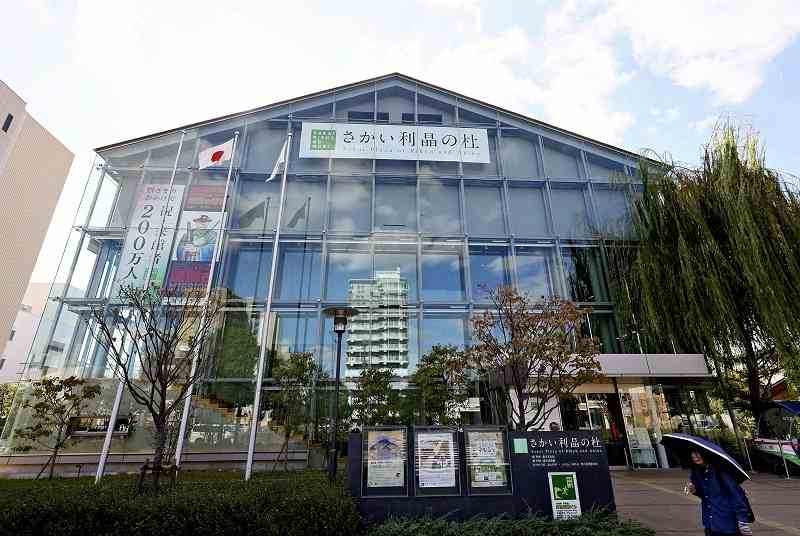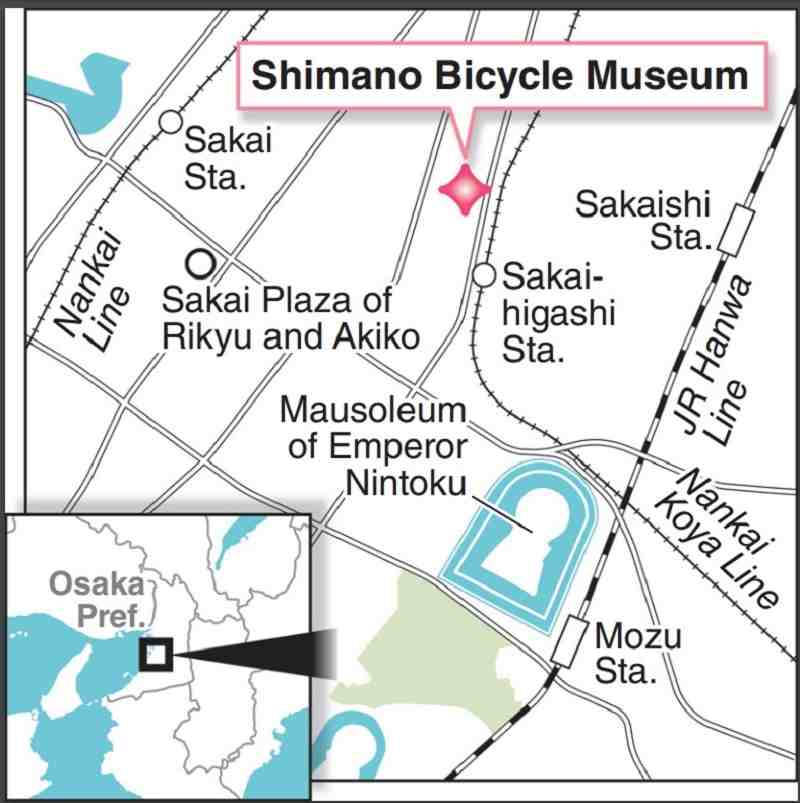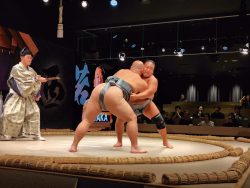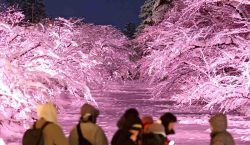
Cyclists ride past the Mausoleum of Emperor Nintoku in Sakai.
11:05 JST, December 3, 2022
SAKAI — Sakai, the second-largest city in Osaka Prefecture, is known as “the city of bicycles” because it has long been the home of many manufacturers of bicycle parts. If you trace the history, you will find the technology for bicycle manufacturing goes back about 1,600 years.
That period was a time when rulers in Japan were actively building burial mounds for themselves called “kofun.”
Sakai is also known for being dotted with many such tombs. One of the world’s largest tombs — the mausoleum of Emperor Nintoku, or Daisen Kofun — is located here, forming part of the World Heritage site of the Mozu-Furuichi Kofun Group (tumulus cluster).
Sakai also flourished as a merchant town in the 15th and 16th centuries and still boasts a rich culture. What are the connections between the city’s long history and the bicycle industry?
Cycle around tombs
In late October, Kosuke Yamaoka from Wakayama cycled around the mausoleum of Emperor Nintoku. The mausoleum is located along the recommended cycling route that tours the tumulus clusters, set up by the Sakai Tourism and Convention Bureau Public Interest Incorporated Association.
“I felt great riding through the magnificent scenery,” Yamaoka, 27, said.
The association has also set a cycling course around the old town area of the city, which gives visitors a sense of the 15th and 16th centuries. Bicycles can be rented for the tours, and the city is busy with cyclists on weekends.
Under the slogan “the city of bicycles,” the association also promotes a cycle rickshaw business and operates three-wheeled roofed vehicles made of parts manufactured by local companies. While getting a guided tour from the driver, passengers can visit famous and historic sites, including the birthplace of poet Yosano Akiko (1878-1942).
In central Sakai, there are several railways running in a north-south direction, but not in an east-west direction, which makes non-rail transportation important.
“Bicycles are vital for sightseeing in Sakai. We want to further enhance this business,” said Kazuhiro Gotanji, the association’s general secretary.
Influx of ironsmiths
What does it mean when we say that Sakai’s bicycle industry has its roots in the construction of kofun mausoleums?
To build a huge mausoleum, iron tools such as hoes and plows were needed, so many ironsmiths moved into the area, contributing to the development of metalworking techniques here.
Ironsmiths’ skills were used in the production of matchlock guns in the warring states period of the 15th and 16th centuries, and in the production of blades after the 17th century, under the Tokugawa Shogunate.
Bicycles were introduced to Japan in the late 19th century, when Japan opened up to the West. The techniques of Sakai’s manufacturers, which had been passed down through the generations, began to be used for bicycle repairs. More and more manufacturers began making iron parts for bikes.

Visitors look at bicycle parts and other items at the Shimano Bicycle Museum in Sakai.
Museum opens
Shimano Bicycle Museum opened this spring near Sakaihigashi Station on the Nankai Koya Line to introduce the history and charms of bicycles. The museum is run by a public interest incorporated foundation related to the nation’s major bicycle parts maker Shimano Inc., which is based in Sakai.
The museum was originally located near the mausoleum of Emperor Nintoku, but was moved to its current location with a display area that is 3.5 times larger to attract more visitors.
The museum displays replicas of valuable bicycles, including the Draisine invented in the early 19th century that is propelled by kicking the ground, and the late-19th-century Ordinary high-wheeled bicycle that has a large front wheel. Videos and a timeline showing Sakai’s connection with bicycles can also be seen.

A replica of the Draisine, a bicycle prototype that has no pedals, at the Shimano Bicycle Museum
The museum also promotes health and environmental awareness through bicycles.
“In addition to the city’s long and deep relationship with bicycles, we want to inform visitors of how bicycles enrich people’s lives,” museum councilor Masahiko Jimbo said.
The city of Sakai offers the chance to learn about history and culture while making people aware of health and nature.
Extend your trip!
Sakai Plaza of Rikyu and Akiko

Sakai Plaza of Rikyu and Akiko
This is cultural and tourism facility that opened in 2015 to introduce Sakai’s history and culture from the viewpoints of tea master Sen no Rikyu (1522-1591) and the poet Yosano Akiko, who both hailed from the city.
In the Sen no Rikyu Chanoyu Museum, there are rooms in the facility set up to introduce Rikyu, and kabuki actor Kataoka Ainosuke, who serves as Sakai Goodwill Ambassador, provides audio commentary. In addition to the permanent exhibition, events are held for experiences such as the tea ceremony, or chanoyu.
How to get there

The Shimano Bicycle Museum is a five-minute walk from Sakaihigashi Station on the Nankai Koya Line. Sakai Plaza of Rikyu and Akiko is one minute from Hankai Tramway’s Shukuin Station or 10 minutes from Sakai Station on the Nankai Line. The Mausoleum of Emperor Nintoku can be reached in about 10 minutes from Mozu Station on the JR Hanwa Line.
Related Tags
"Features" POPULAR ARTICLE
-

Students Recreate 19th-Century Bento Boxes Made for Ino Tadataka’s Survey Team in Hot Spring Town on Nakasendo Road
-

Santa Claus Delivers Christmas Presents to Penguins at Aquarium in Japan’s Nagasaki Prefecture
-

Sumo Restaurant in Tokyo Teaches Foreign Visitors About the Ancient Sport, with Bouts Between Retired Rikishi
-

Autonomous Passenger Ship Connects Mainland with Remote Island in Seto Inland Sea; World’s 1st Commercially Operated Autonomous Vessel
-

Osaka’s Sumiyoshi Taisha Shrine Bustles with New Year’s Visitors
JN ACCESS RANKING
-

As Chinese Tourists Shun Japan, Hotels and Stores Suffer
-

Osaka-Kansai Expo’s Economic Impact Estimated at ¥3.6 Trillion, Takes Actual Visitor Numbers into Account
-

Japan Govt Adopts Measures to Curb Mega Solar Power Plant Projects Amid Environmental Concerns
-

BOJ Gov. Ueda: Highly Likely Mechanism for Rising Wages, Prices Will Be Maintained
-

Economic Security Panels Debate Supply Chains, Rare Earths; Participants Emphasize Importance of Cooperation Among Allies

























